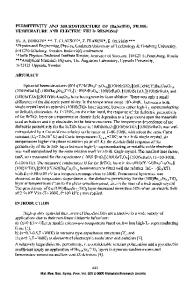Role of Enthalpy and Relative Electric Permittivity in Electric Field Induced Nucleation
- PDF / 324,282 Bytes
- 6 Pages / 612 x 792 pts (letter) Page_size
- 107 Downloads / 390 Views
Role of Enthalpy and Relative Electric Permittivity in Electric Field Induced Nucleation K. Kohary, J. Vazquez-Diosdado, P. Ashwin, and C. D. Wright College of Engineering, Mathematics, and Physical Sciences, University of Exeter, Harrison Building, North Park Road, Exeter, EX4 4QF, United Kingdom ABSTRACT Emerging phase-change electrical memory technologies rely on the fast amorphous to crystalline transition, which is usually characterized by an ‘S-shape’ current-voltage curve. We investigate the possibility that electric field induced nucleation may play a dominant role in defining this characteristic electrical switching behavior. We derive quantitative crystallization maps to study the kinetics of the amorphous to crystalline transition in the presence of electric field contribution to the free energy and we investigate how the prediction of the electric field induced nucleation model is affected by material properties such as enthalpy and relative electric permittivity. INTRODUCTION Phase-change devices are emerging as a promising technology for future non-volatile, solid-state, electrical storage [1], and are considered in ultra high density scanning probe-type memories [2], and more speculatively in applications with arithmetic, neuromorphic, and memristor type functionality [3]. Phase-change materials are of intense research interest due to their unique combination of structural, electronic, and optical properties [4]. The amorphous and crystalline states are both stable at room temperature and exhibit a large difference in optical reflectivity and electrical resistance. At the same time the transition between the two phases can be achieved on the sub-nanosecond timescale. However, the precise nature of the transition from the amorphous to crystalline phase is still a topic of considerable debate. This is especially true for the electrical switching in phase-change memories, which is usually characterized by an ‘Sshape’ current-voltage curve for the amorphous to crystalline transition. Several alternative mechanisms have been put forward to account for this ‘S-shaped’ switching including PooleFrenkel effects, delocalization of tail states, field-emission processes, and space-charge limited currents, as discussed in detail in Refs [5,6]. However, an alternative to these electronic based theoretical models is including electric field dependence contribution to the free energy in the classical nucleation model. The nucleation model has been successfully employed previously to describe the phase transformation due to temperature in phase-change materials. In addition, when employing it to electrical switching in phase-change memories, this model has been proven to be successful to explain experimental observations including the relationship between threshold voltage, device thickness, temperature and switching delay time [7-9]. We previously employed this electric field induced nucleation model to develop a kinetic description of the phase-transition [10] in order to determine the temperature and electric field
Data Loading...











